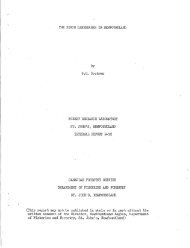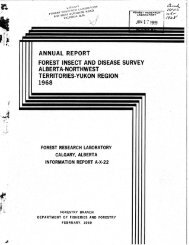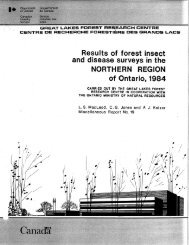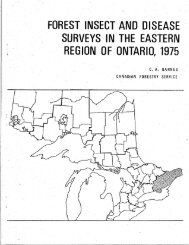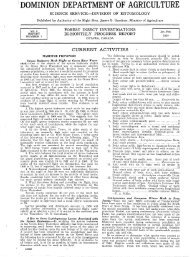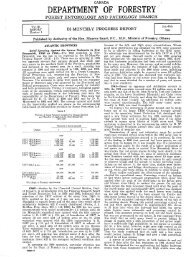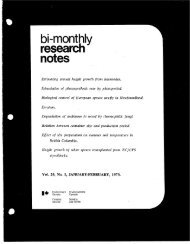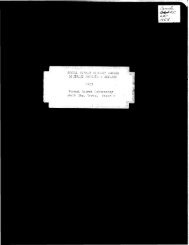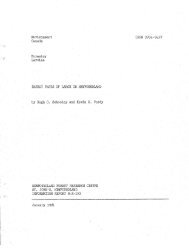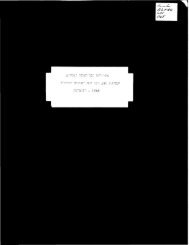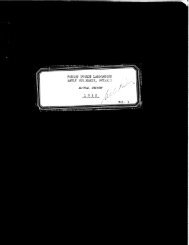Annual District Reports: Forest Insect and Disease Survey ... - NFIS
Annual District Reports: Forest Insect and Disease Survey ... - NFIS
Annual District Reports: Forest Insect and Disease Survey ... - NFIS
You also want an ePaper? Increase the reach of your titles
YUMPU automatically turns print PDFs into web optimized ePapers that Google loves.
- 12 -<br />
2.2.h Yellow-headed Spruce Sawfly, Pikonema alaskensis (Roh.):-<br />
Caused light to moderate defoliation of a few widely scattered open-growing<br />
white spruce at Lake St. George <strong>and</strong> on three ornamental spruce at<br />
Beaver Creek. Elsewhere populations were very low <strong>and</strong> defoliation<br />
negligible.<br />
2.2.5 Pine Needle Scale, Phenacaspis pinifoliae (Fitch):- Young<br />
scales were active by June 10 <strong>and</strong> relatively high populations were<br />
noted on the foliage of planted white <strong>and</strong> Colorada spruce at several<br />
locations. Light to moderate (<strong>and</strong> occasionally severe) infestations<br />
occurred in Assiniboine <strong>and</strong> Kildonan parks but were generally light<br />
elsewhere in Metropolitan Winnipeg, <strong>and</strong> moderate to heavy damage was<br />
recorded in spruce shelterbelts in the Somerset <strong>and</strong> Pilot Mound areas in<br />
west-central Manitoba. In addition, two small areas of light infestation<br />
were recorded on jack-pine in the Interlake section; one located<br />
seven miles north of the Fairford River on Highway No. 6 <strong>and</strong> the other<br />
at Mile 45 along the Sypsumville-Gr<strong>and</strong> Rapids Highway.<br />
2.2.6 Balsam-fir Sawfly Neodiprion abietis complex:- Populations of<br />
this defoliator continued to decline in the Interlake section, <strong>and</strong> it was<br />
not recorded in southwestern Manitoba (Fig. Ii). Larval collections were<br />
taken from white <strong>and</strong> black spruce near Riverton, Red Rose Tower, Arborg<br />
<strong>and</strong> Fairford, but resultant defoliation was very light in these areas.<br />
2.2.7 A Shoot Moth on Jack Pine, Eucosma gloriola (Hein.):- This shoot<br />
moth was more widespread than in 1962, but the incidence of damaged jack<br />
pine leaders remained relatively light in all areas. The infestations<br />
near Dawson Cabin <strong>and</strong> Woodridge in southeastern Manitoba coalesced <strong>and</strong><br />
exp<strong>and</strong>ed to form an almost continuous infestation throughout young jack<br />
pine st<strong>and</strong>s in the area extending from Piney <strong>and</strong> South Junction through<br />
Vassar, S<strong>and</strong>il<strong>and</strong>s <strong>and</strong> March<strong>and</strong> to East Braintree. The infestation<br />
previously reported in the Interlake section also increased in size <strong>and</strong><br />
larval collections were taken as far as Mile 28 north of Gypsumville.<br />
2.2.8 Spruce Spider Mite, Oligonychus ununguis (Jac.):- Spider mites<br />
were common during the early part of the season <strong>and</strong> caused moderate to<br />
severe injury to ornamental Colorada <strong>and</strong> white spruce in residential <strong>and</strong><br />
park areas throughout Metropolitan Winnipeg. Elsewhere, light infestations<br />
were recorded in the Carberry <strong>and</strong> Camp Hughes areas in southwestern<br />
Manitoba.<br />
2.2.9 <strong>Forest</strong> Tent Caterpillar, Malacosoma disstria Hbn.:- The forest<br />
tent caterpillar again caused serious defoliation of trembling aspen<br />
st<strong>and</strong>s in several locales throughout the Interlake section but remained at<br />
endemic levels in southwestern Manitoba (Fig. 6). The old infestation



